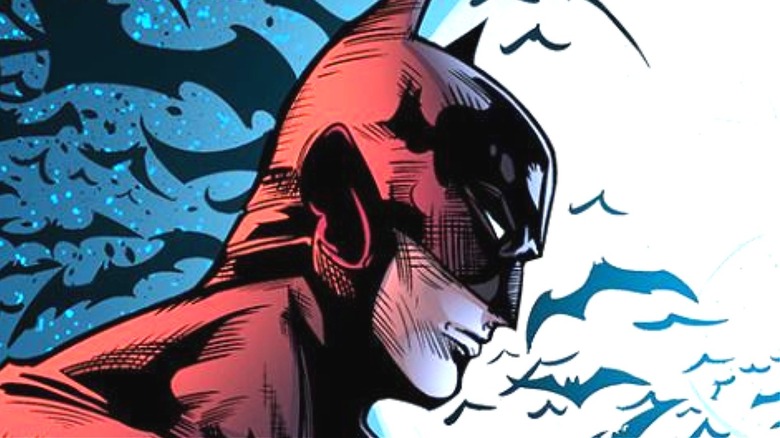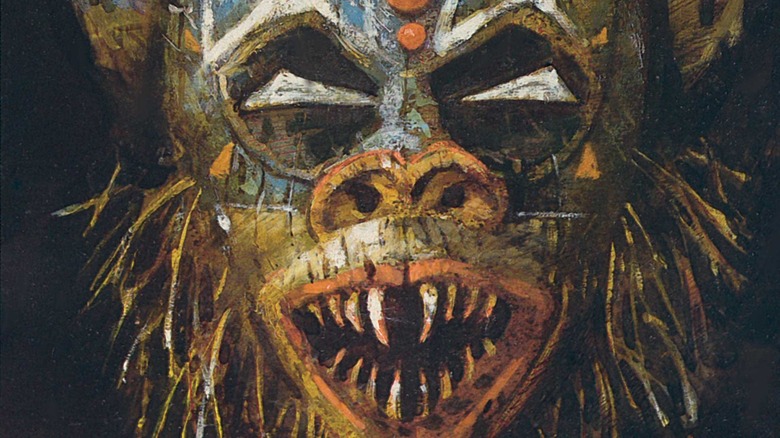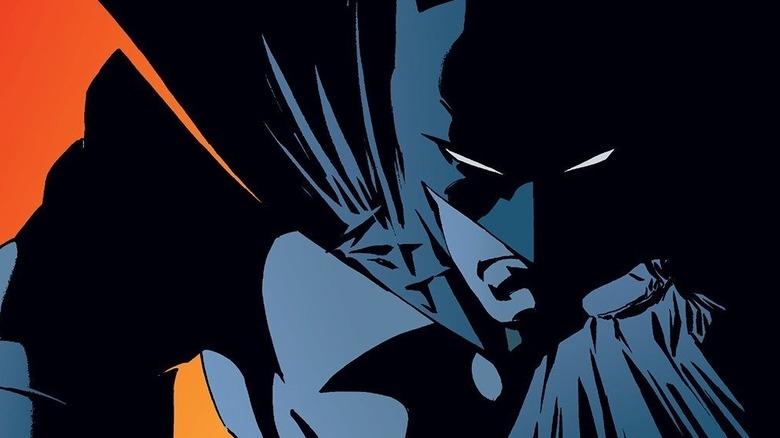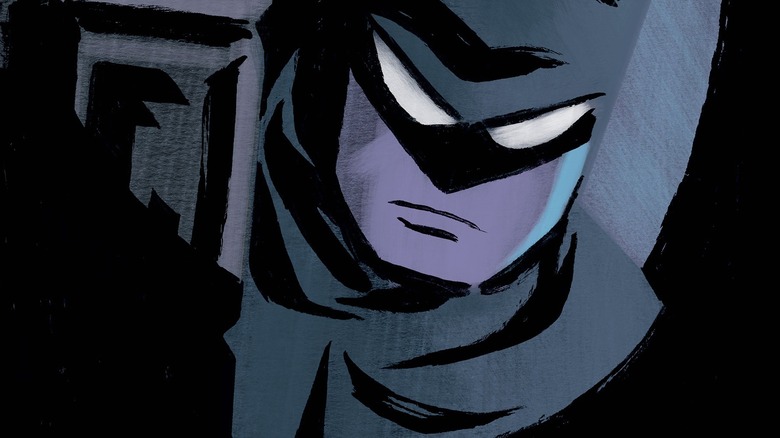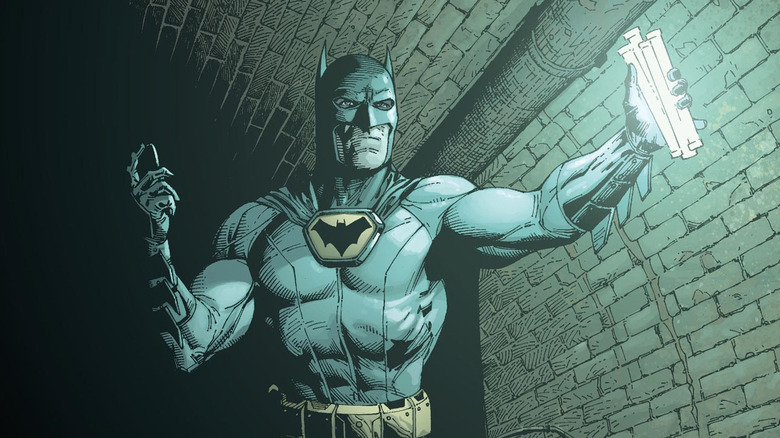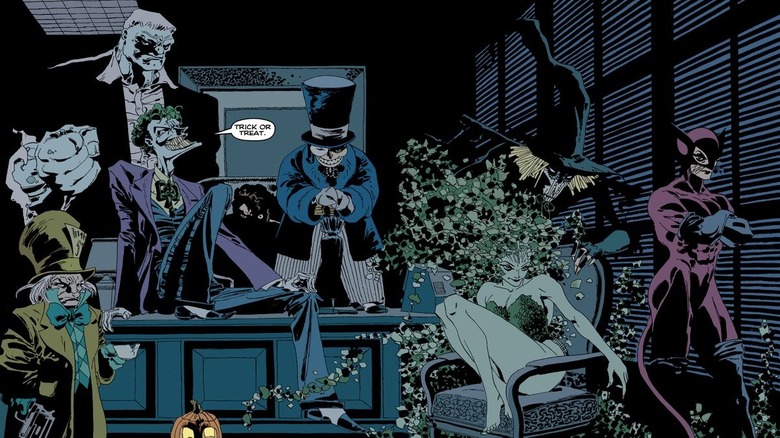These Are The Comics That Inspired Robert Pattinson's Batman
With "The Batman" now in theaters, audiences have a brand-new iteration of the Dark Knight in the form of Robert Pattinson's Bruce Wayne. A younger and less experienced version of Batman than the previous silver screen portrayal by Ben Affleck, Pattinson's Batman is pensive, angry, and (by the end of the film) a beacon of hope for the citizens of Gotham City. With "The Batman" off to a big start at the box office, it seems that there are plenty of reasons to be hopeful for more adventures with Pattinson's Caped Crusader.
It is also clear that Pattinson has done his homework to put on the cape and cowl. In fact, in a recent interview with Entertainment Weekly alongside "The Batman" director Matt Reeves, Pattinson broke down some of the significant comic book inspirations that helped guide his interpretation of Bruce Wayne and his darker alter ego. There are some notable deep cuts to DC lore, so let's take a look at some of the comics that helped shape this version of Batman.
Robert Pattinson took inspiration from Batman: Shaman
One of the biggest sources of inspiration that Robert Pattinson drew from for his portrayal of Batman was the 1989 Batman story, "Batman: Shaman." That story chronicles a young Bruce Wayne learning a myth of how bats gained the ability to fly while being nursed back to health by a shaman in the Alaskan mountains after sustaining injuries during his training. Bruce later brings the lessons he learns, both the literal and metaphorical, back with him to Gotham City, where he's confronted with enemies who appear to be drawing from similar shamanic influences.
"It's almost a dream state the whole time," Pattinson said, explaining his take on the comic. "I was like, 'Oh, that hasn't really been touched on.' There's a kind of mysticism to it." This story helped inform how he operated in his Batsuit, allowing him to feel like a "wraith" in his movements and tap into something more spiritual than previous "Batman" movies.
Part of the appeal to this "mysticism" element lay in how Batman related to the institutional crime-fighting elements of Gotham City. Explaining this rationale, Pattinson said, "I was trying to play that, trying to think: 'How can you be a detective when you are wearing this outfit, which is the opposite of a detective?' I thought, it's kind of [like] he's a witch doctor more than anything else. And the more you get it right, the more the police believe him, and so they start letting him into crime scenes and stuff."
Robert Pattinson consulted Birth of the Demon for his Batman, as well
Another "Batman" comic called out as a source of inspiration for Robert Pattinson's take on "The Batman" was "Batman: Birth of the Demon." Published in 1992, the book is the third in a series of "Batman" issues by Dennis O'Neil, capping off a story that began with "Son of the Demon," and continued with "Bride of the Demon." It follows the love story between Batman and Talia al Ghul, and also features the villainous Ra's al Ghul, leader of The League of Assassins, who appeals to Bruce to become his heir and join him on a quest for world domination.
Neither Ra's al Ghul nor The League of Assassins makes an appearance in "The Batman," which is arguably for the best as Christopher Nolan already utilized them for "Batman Begins" and "The Dark Knight Rises." However, "Birth of the Demon" is similar to "Batman: Shaman" in that it introduces elements of mysticism to Batman's lore. In an interview with Den of Geek Magazine, Pattinson also named "Birth of the Demon" as one of his favorite "Batman" stories that he dug into as he researched the role, alongside fan favorites such as "Arkham Asylum: Serious House on Serious Earth" and "The Man Who Falls."
The psychological elements of Batman: Ego served as inspiration
While speaking with Entertainment Weekly about his inspiration for "The Batman," Robert Pattinson also referenced Darwyn Cooke's "Batman: Ego," another murder mystery that sees Bruce mentally broken by the guilt of knowing that the information he extracted from a Gotham thug led to that henchman's suicide. From there, the personas of Bruce and Batman split in his mind, leading to a climactic confrontation between the two.
That exploration of duality between Bruce Wayne and his dark side helped the actor dig into that abnormal psychology. Describing how "Ego" helped him understand the mindset behind Batman, Robert Pattinson told Entertainment Weekly, "I started thinking about Jekyll and Hyde and the idea of the shadow side. Ego really gets into this idea of the beast within him and that struggle. So, that got into the really internal, psychological struggle of being Batman. In a lot of the comics, he has trouble differentiating reality and his dreams, and in Ego as well."
"The Batman" does not necessarily dig into that divide between Bruce and Batman quite so explicitly — especially not when compared to something like "The Incredible Hulk," which more literally explores the "Jekyll and Hyde" nature of its hero. That said, it does examine the duality of the character, as well as how Batman's psychological war on the criminal element of Gotham affects his own mental health, which is very similar to how "Batman: Ego" ultimately plays out.
Batman: Earth One was another reference point for Robert Pattinson's Batman
One other "Batman" title specifically called out as a source of inspiration for Robert Pattinson's take on Batman is "Batman: Earth One." Written by Geoff Johns, this version of Batman brings the comic book hero down to a grittier street level compared to many of the other interpretations of the character. The book follows a young Bruce in the early days of his Batman career as he investigates the murders of his parents and explores possible involvement by Mayor Oswald Cobblepot. Grounded in realism to a fault, it is also one of the few "Batman" comics to show Bruce's eyes through the cowl when he is out on patrol as Batman, rather than the usual white eyes that have become so iconic.
The inspiration that "The Batman" draws from "Batman: Earth One" is fairly plain to see. The film is considerably more grounded and realistic than other versions of the character that have been on the big screen, with Bruce making numerous mistakes and gradually growing into his role as Batman throughout the story. Moreover, the book takes a much closer look at the types of people Thomas and Martha Wayne were prior to their deaths and makes their demise in Crime Alley a conspiracy that Bruce needs to untangle and come to terms with as the books progress.
Robert Pattinson and Matt Reeves also looked to several classics
While Robert Pattinson's Bruce Wayne clearly took inspiration from some more obscure corners of Batman lore, "The Batman" is also full of inspiration from more well-known "Batman" comics. In fact, two titles called out as inspiration are "Batman: The Long Halloween" and "Batman: Dark Victory," two noted favorites of former Batman Christian Bale (per UGO).
In fact, Reeves noted that he had a connection to the writer of those stories: Jeph Loeb. In his interview comments to Entertainment Weekly about the inspiration for "The Batman," the director said, "It's so weird because I didn't know till I did all of this deep dive that it was literally my screenwriting teacher from USC — the person who told me that I should become a writer — Jeph Loeb, who wrote those stories."
Like "The Batman," both of these titles take place early in Batman's career while not re-treading his first year. Both also follow Batman on the trails of vicious serial killers. In "The Long Halloween," Batman pursues The Holiday Killer, while in "Dark Victory," he goes after a murderer called The Hangman. These stories, like "The Batman," also explore Batman's impact on Gotham City and how his success as a vigilante is tied to the eventual collapse of traditional organized crime. This is what leads to the rise of more theatrical bad guys like The Joker.
While it's currently unclear what the potential plot of a sequel to "The Batman" might look like, these points of inspiration create numerous avenues to explore.
